MXA RACE TEST: THE REAL TEST OF THE 2020 SUZUKI RM-Z250
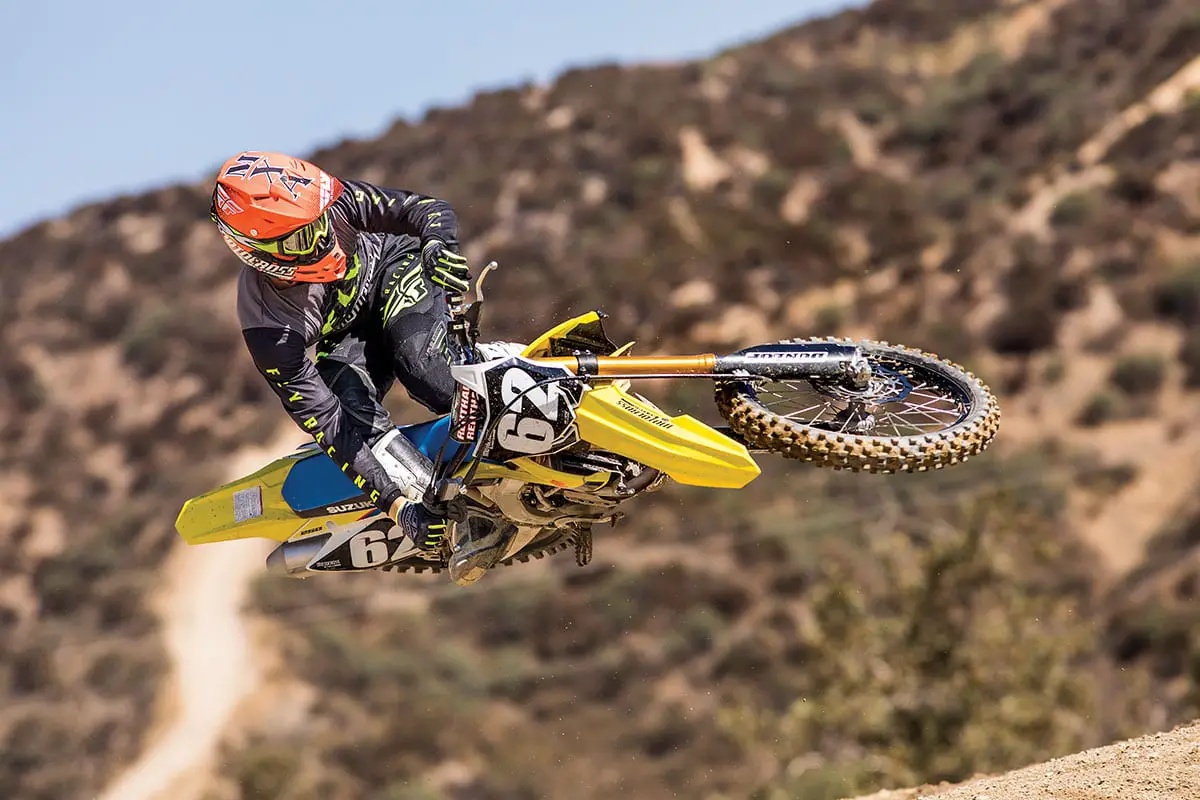
THE FULL REVIEW OF THE 2020 SUZUKI RM-Z250
Q: FIRST AND FOREMOST, IS THE 2020 SUZUKI RM-Z250 BETTER THAN THE 2019 RM-Z250?
A: No, not by any stretch of the imagination. While the green, orange, white and red 250cc four-strokes were improved for 2020, the yellow RM-Z250 fell further behind the eight ball.
Q: HAS ANYTHING BEEN UPDATED ON THE RM-Z250 FOR 2020?
A: Yes, but only if you count changing the color combination on the tank graphics. But let’s not forget the laundry list of changes that were made on the 2019 RM-Z250. Last year the RM-Z250 got an updated frame, Kayaba forks, a bigger front rotor, dual injectors, new shock, revised cylinder head and new plastic. All of these updates made the bike significantly better, save for the brutally stiff forks.
The changes to the 2019 RM-Z250 made more power from a low 6700 rpm all the way to sign-off. It made 2-horsepower more high in the rpm range. This is exactly what the RM-Z250 needed. It has always offered good low- to midrange power, but was gutless on the top end prior to 2019. The engine updates in 2019 took the RM-Z250’s powerband to a higher level. 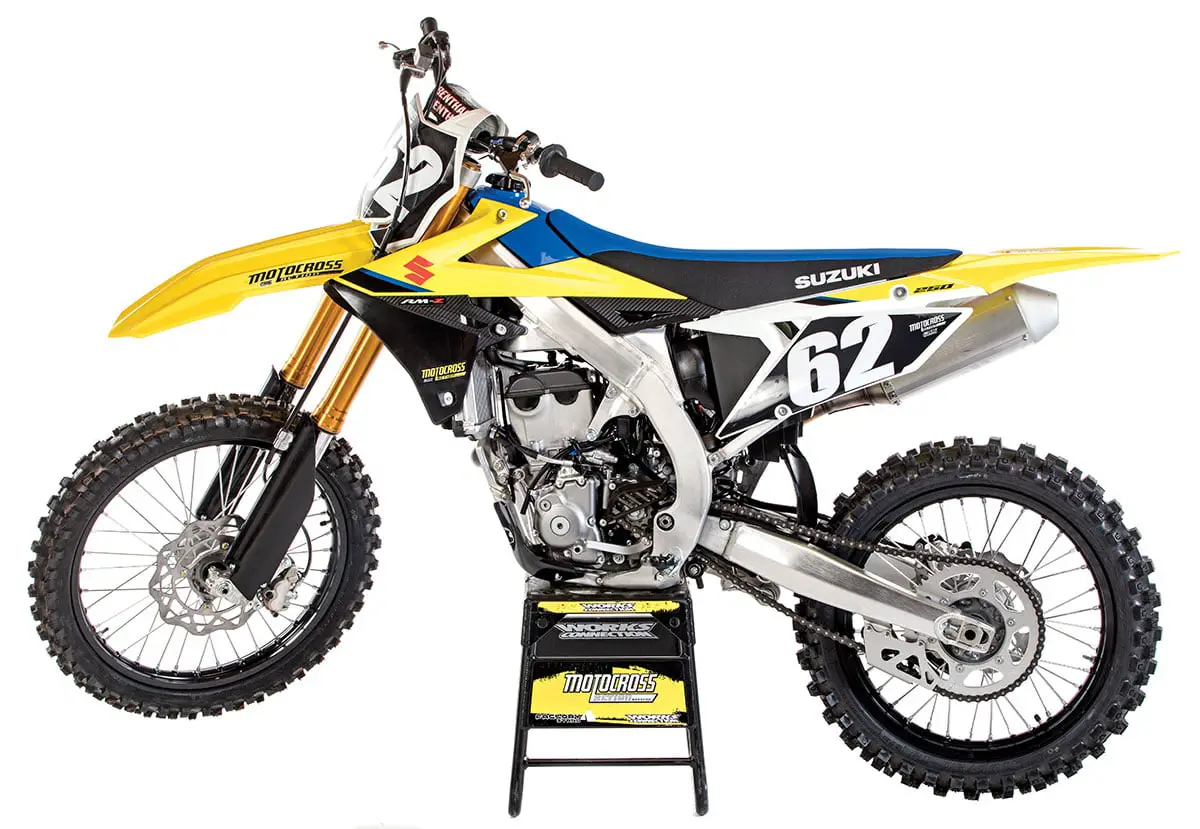
Q: HOW DOES THE RM-Z250 STACK UP AGAINST THE COMPETITION?
A: Every bike in the 250 four-stroke class offers a clean, practical and reliable package. Unfortunately for the 2020 RM-Z250, it is not highly sought after by serious racers. It offers the least peak horsepower in its class by about 3 horsepower. A good exhaust system could bring the RM-Z250 up to the peak power of the only other midrange engine in the class of 2020—the Yamaha YZ250F. But, you’d be tacking $1000 onto the base price. The inherent problem with this strategy is that you’d be paying extra to push the RM-Z250 up to competitive levels, which only brings parity against the competition as long as the competition doesn’t add an aftermarket exhaust of their own. In a way, making a slow bike faster is like a cat chasing its tail; it can get close, but there is ultimately no satisfaction.
With its low-to-mid powerband, the 2020 Suzuki is one of the easiest bikes to ride. It is at its strongest below 8000 rpm, and there is no benefit to revving it past its 11,600-rpm peak. The power is instantly attainable at low rpm but relatively mellow after 8000 rpm. Its easygoing nature makes it perfect for young riders who aren’t ready for the fire-breathing, 14,000-rpm powerbands of the 2020 KTM 250SXF, Husqvarna FC250, Honda CRF250 and Kawasaki KX250. To make a 2020 RM-Z250 the equal of the class-leading 250cc Amateur or AMA-class race engines, such as the KTM 250SXF, would take $4000 in porting, pipe, piston, cam and ignition mods.
The 2020 Suzuki RM-Z250 has an attractive $7899 base price. The best advice is to ride it as it is, enjoy it for its ease of use, and don’t go chasing your tail in pursuit of the $9099 wonder bikes.
Q: HOW GOOD ARE THE KAYABA COIL SPRINGS?
A: Actually, we meant to ask, “How bad are the Kayaba coil spring forks?” They aren’t good; they are terrible. We don’t understand Suzuki’s logic in making forks that are Supercross-stiff. This is the fourth time in the last seven years that the Suzuki engineers have made this mistake. The 2014 RM-Z450 and 2017 RM-Z450 forks were stiff enough for Weston Peick to race Supercross on. The 2019 and 2020 RM-Z250 forks come with 5.0 N/mm springs in them. That is the same spring that Honda, Yamaha, Suzuki and Kawasaki run in their 450 forks. In contrast, the Kayaba coil spring forks on the 2020 YZ250F are 4.7 N/mm springs. Take our word for it, the 2020 Suzuki RM-Z250 forks are too stiff for the typical 250 racer—be he a Novice, Intermediate or Pro.
Looking at the glass half full, the RM-Z250 Kayaba units are exceptional components (as proven by how well they work on other brands). Internally, they have the same capabilities as other forks in the class with softer spring rates. Changing the spring rates is the bare minimum you can do to get back in the ballpark.
 The 2020 Suzuki RM-Z250 engine offers good bottom to mid-range power, but lack top-end pizazz.
The 2020 Suzuki RM-Z250 engine offers good bottom to mid-range power, but lack top-end pizazz.
Q: WHICH PLUG-IN COUPLER DID WE USE?
A: The Suzuki RM-Z250 comes with three easy-to-use fuel couplers that change the EFI tuning. We don’t waste our time with the grey or black couplers. The white coupler is the most aggressive off the bottom and gets the rpm to rev through its range faster. Every MXA test rider chose the white coupler, as it produced the most responsive power.
Q: IS THE RM-Z250 STILL A TURN-AT-ALL-COSTS CHASSIS?
A: When the chassis was updated in 2019, Suzuki put even more emphasis on the front end. We hate it when the engineers mess with a good thing. The inherent problem with Suzuki’s new frame geometry is that it never got a fair chance to work. The overly stiff forks wreaked havoc on the hoped-for turning response. Without the ability to drop into its stroke at the apex of turns or absorb braking bumps on the way into a corner, the forks ruined the frame. Every MXA test rider chased after a balanced setup on the RM-Z chassis, but this required sliding the fork up in the triple clamps to get more weight on the front end, which had the corollary effect of forcing us to drop the rear sag to 107mm to keep the chassis flat. At this lower setup, the bike carves like a knife, but, on fast, rough straights, it gets shaky. This is the price you pay for the suspension engineers’ mistake.
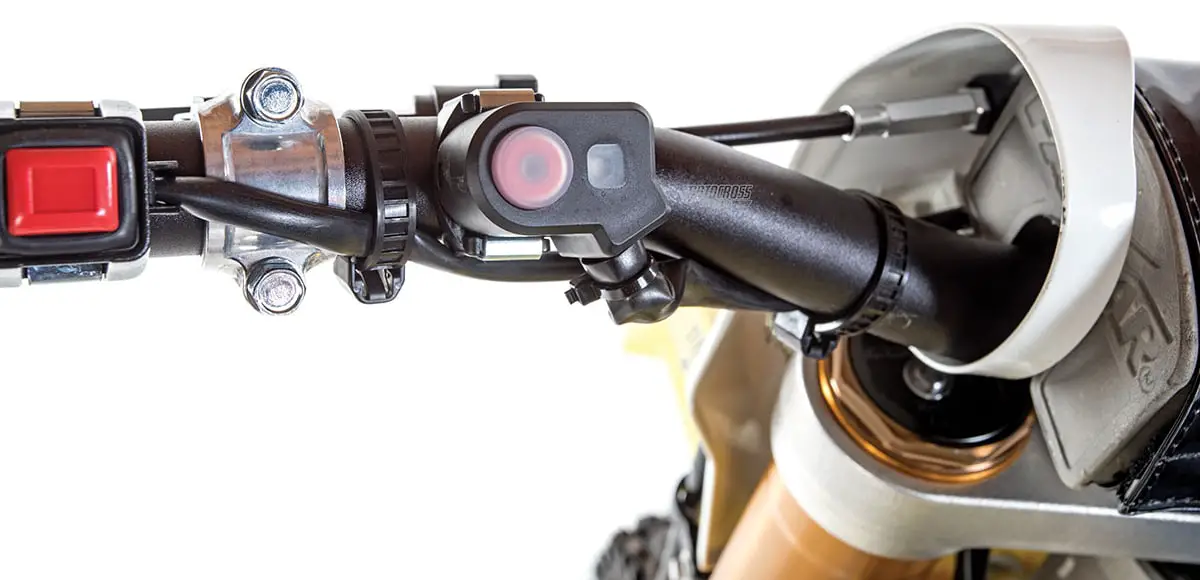 The holeshot assist button. Maps are changed with three plug-in couple.
The holeshot assist button. Maps are changed with three plug-in couple.
Q: WHO IS THIS BIKE BUILT FOR?
A: Paradoxically, the 2020 Suzuki RM-Z250 should be built for young, small, entry-level riders who weigh around 220 pounds. That particular body type is in plentiful supply in the 250 Novice class. In a better world, where the correct spring rates magically appear on the 2020 RM-Z250, the compact cockpit is tailored towards shorter riders. The engine is incredibly easy to use, and the power is supremely manageable.
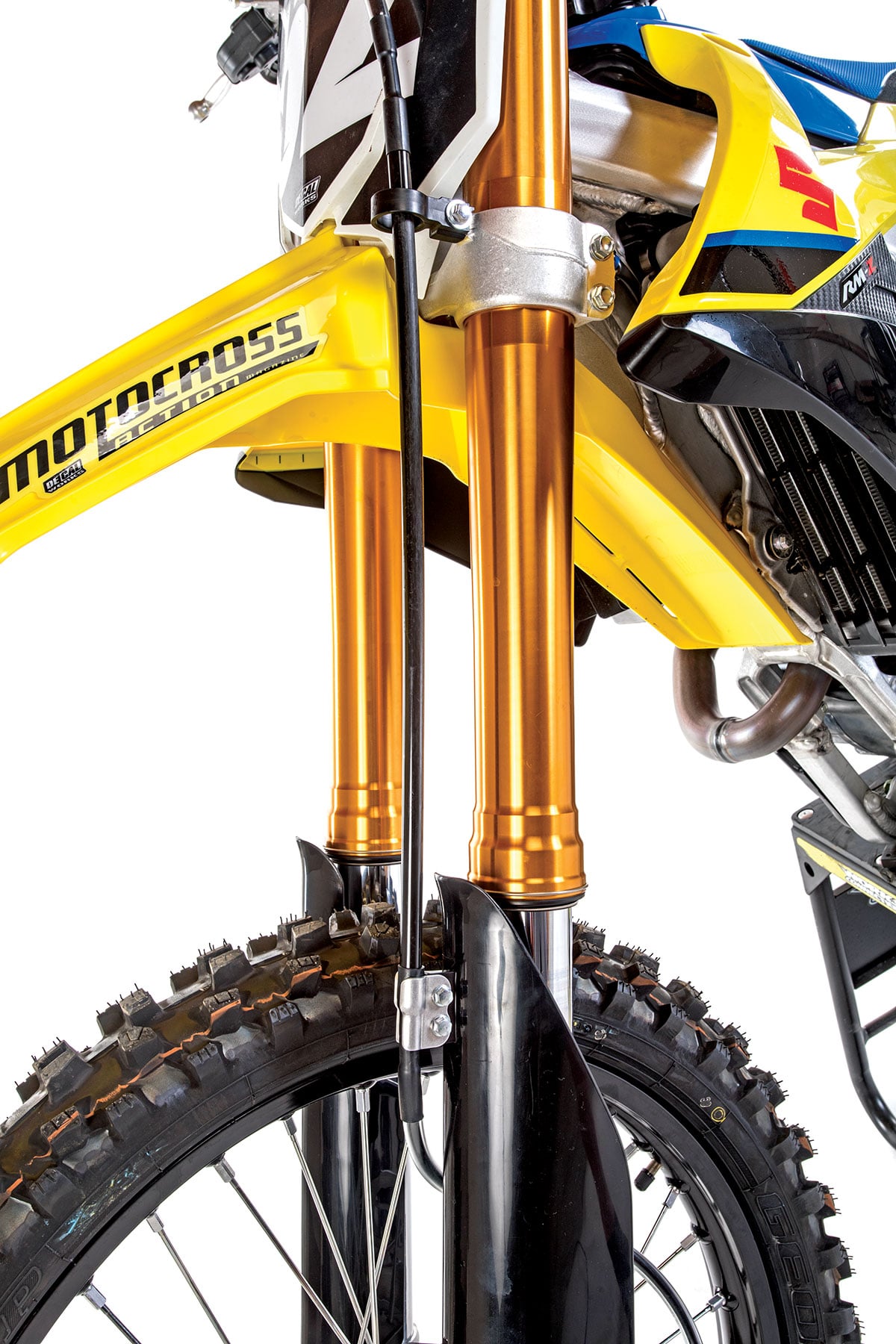 The worst part of the 2020 Suzuki RM-Z250 is its atrociously stiff Kayaba forks. These forks are set-up for a 450, not a 250.
The worst part of the 2020 Suzuki RM-Z250 is its atrociously stiff Kayaba forks. These forks are set-up for a 450, not a 250.
Q: WHAT IS SUZUKI MISSING FOR 2020?
A: The RM-Z250 is in no-man’s land for 2020. Every time the RM-Z250 gets an opponent in sight, the green, red, blue, orange and white competition grab another gear and pull away on the R&D front. The sad thing for a bike with as great a race heritage as the RM-Z250 is that it has become more of a trail bike than a race bike. If Suzuki doesn’t innovate quickly, the RM-Z250 is in danger of not being taken seriously by in-the-know motocross bike buyers.
We know there is a void in the market for an affordable dirt bike that can bridge that gap between $5000 play bikes and $9000 race bikes. And that very well could be Suzuki’s niche. With a little price-cutting and careful product planning, the RM-Z250 of the future could offer the American off-road consumer a bike with an excellent chassis and workman-like powerband that can handle a motocross track without a high price tag. People complain all the time about how much bikes cost today, then they complain because they don’t have every electronic doodad known to man on them. We think that there is a built-in market for a good race bike at an affordable price.
Q: WHAT DID WE HATE?
A: The hate list:
(1) Clutch. At the lever, the clutch has the easy pull that everyone loves. Unfortunately, that easy pull translates into the friction plates needing to be replaced more frequently. Put stiffer springs in on day one.
(2) Forks. The RM-Z250 forks are set up perfectly for a Detroit Lion’s defensive tackle.
(3) Transmission. The gears are notchy when shifted under a load.
(4) Launch control. This is a dummy switch. There is no way that the mellowest 250 four-stroke on the market needs to mute its power at any time.
(5) Electric start. It is mandatory to have an electric start in 2020—Suzuki didn’t get the memo.
(6) Weight. At 226 pounds (without fuel in the tank), it is too heavy. Given that it doesn’t have electric start, we can only imagine how much it would weigh with it.
(7) Vibration. This bike vibrates more than any bike in its class.
(8) Engine. For 2020, KTM, Husqvarna, Kawasaki and Honda have 14,000-rpm engines that produce 43 horsepower. The 2020 Suzuki RM-Z250 makes 39 horsepower.
Q: WHAT DID WE LIKE?
A: The like list:
(1) Cornering. Given more practical suspension, the RM-Z250 is the best cornering bike in its class. It gets in the corner with ease and doesn’t oversteer or want to stand up in the middle of the corner.
(2) Durability. In the past, Suzuki has had some serious reliability issues, but in recent years we have had no catastrophic issues with the RM-Z250.
(3) Tires. We like the Dunlop MX33 front and MX33 rear tires.
Q: WHAT DO WE REALLY THINK?
A: The MXA test riders want to love this bike and, at times, we do, but then a big hill appears in front of us.
MXA’S 2020 SUZUKI RM-Z250 SETUP SPECS
This is how we set up our 2020 Suzuki RM-Z250 for racing. We offer it as a guide to help you find your own sweet spot.
KAYABA COIL-SPRING FORK SETTINGS
The stock 5.0 N/mm spring rate is too stiff for any skill level. By dropping the spring rate down, we were able to use most of the travel. For hard-core racing, these are MXA’s recommended 2020 Suzuki RM-Z250 fork settings (stock settings are in parentheses):
Spring rate: 4.9 N/mm (5.0 N/mm)
Compression: 14 clicks out (11 clicks out)
Rebound: 13 clicks out
Fork-leg height: Standard
Notes: Depending on your weight you can go down on the fork spring rate to 4.8, 4.7 or less. If you opt out of lowering the spring rate, then you will want to run the compression all the way out and drop the oil height by 20cc—unless you are a 200-pounder.
KAYABA SHOCK SETTINGS
To balance out the chassis, we set the sag at 107mm. However, with the overly stiff stock spring rates, test riders would often raised the sag to 104mm to get more weight on the forks to get them to move. For hard-core racing, these are MXA’s recommended 2020 Suzuki RM-Z250 shock settings (stock settings are in parentheses):
Spring rate: 50 N/mm (52 N/mm)
Race sag: 107 mm (110 mm)
Hi-compression (blue): 14 clicks out
Lo-compression (silver): 14 clicks out
Hi-rebound (bottom of shock): 16 clicks out
Lo-rebound (red): 14 clicks out



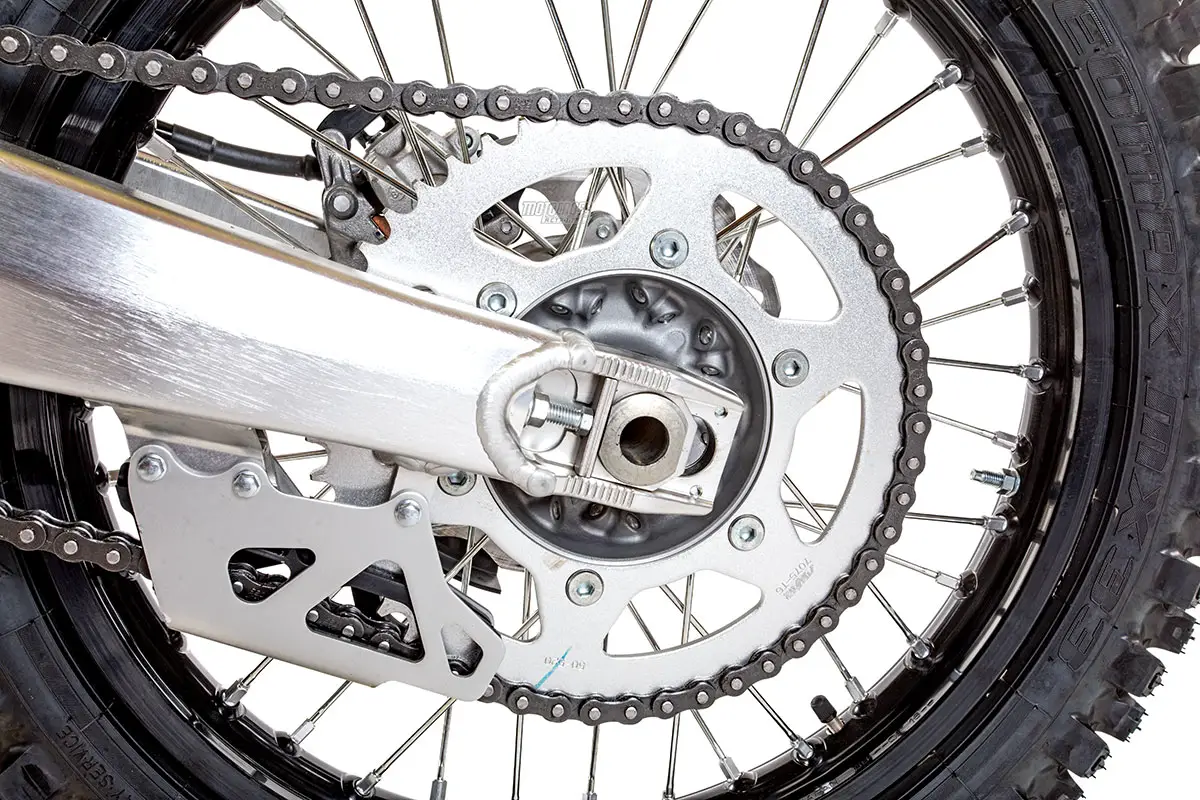



Comments are closed.